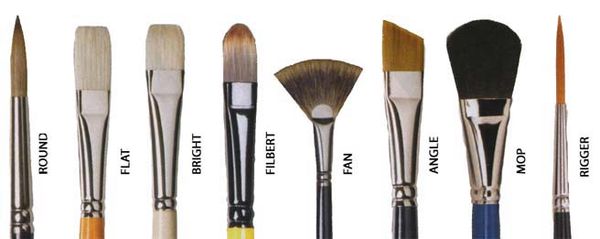I had heard so many claims, spent thousands of dollars on high-quality make-up brushes over the years, for both work and personal use, when one day I had an epiphany: what about artist brushes?
You see, as a side hobby, I took up painting. I noticed similar claims being made about artist brushes, whether they used fine sable-haired or goat-haired bristles, or high-quality synthetic Taklon. Artist brushes also use high-quality woods for handles and are ergonomic and light in the hand, they often use anodized double-crimped metal ferrules that help keep them rust-free and hang on to the bristles better, and come in an almost infinite variety of sizes from tiny (perfect for concealing blemishes, or creating a sharp lip line), to sizes that are ideal for the application of foundation, eyeshadows, highlighting, or contouring.
Artist brushes, even the “best” quality ones at the art supply store, are a fraction of the cost of make-up brushes, even if they look the same, use the same materials for their bristles, and use high-quality anodized metal ferrules. In my experience, artist bristles actually hold up better; I’ve not experienced the kind of “shedding” that occurs so often with make-up brushes as with artist brushes, and the bristles themselves, tend to hold their shape much better over time. They even make artist brushes in shorter-length handles, which would be ideal for make-up application.
You’re not going to find an artist brush at your local art supply store that can take the place of a traditionally shaped powder or blush brush (with that big fluffy head), but you can easily replace, swap out, and find brushes there for foundation application, eyeliner, eyeshadow, brows, concealer, lip, contouring, highlighting–or almost anything else you can think of. Typically, the most expensive artist brushes are in the 40 dollar range (but the majority cost a lot less than that); the most expensive make-up brush brands can cost hundreds of dollars for a single brush. It makes me weep when I think of all the money I’d spent on brushes, and how much money I could have saved over the years.
The other thing to keep in mind, as a general rule: use synthetic bristle brushes for the application of creams and liquids (as the product won’t “stick” and clump the bristles as they would natural animal-hair bristles, such as sable, goat, squirrel, and apply better on the skin), and if you wish, use sable (the softest and finest of the animal-hair bristles) for applications around the eye. Of course, forgo animal-hair bristle brushes completely, if you’re vegan or abhor the use of any animal by-products in cosmetics. The quality of synthetic bristles in brushes, both in artist brushes and make-up brushes, has improved to the point that you can find really soft synthetic brushes that feel like natural animal-hair brushes.
Another advantage of visiting your local art supply store: they often have sales on brushes throughout the year. Many art supply stores have “testers” of the actual brushes, or even sell them loose, so you can feel them on your hand and get a sense of how the bristles spring back, and if you have any questions, you don’t have to feel pressured or intimidated by the usually very helpful art store staff, like what you might experience at the cosmetics counter!
To keep your brushes in good shape, wash them regularly: at least once a week. You can buy a make-up brush shampoo, or just use a drop of a generic mild and gentle shampoo (i.e. no dandruff shampoo or dishwashing liquid) with lukewarm water. Wet the brush a little under the tap, being careful not to get any water into or inside the ferrule. Apply a tiny drop of the shampoo and swirl the brush in the palm of your hand to lather, and rinse under a running tap of lukewarm water–and keep the handle pointed down, so that the water can’t get inside the ferrule. Repeat that lather and rinse step until the water runs clear and the bristles are clean. Tip: use a drop of conditioner every now and then for natural-hair brushes, then rinse, just to keep the bristles soft and smooth.
Gently squeeze out the excess water and air dry flat (NEVER UPRIGHT–the residual water will trickle down inside the metal ferrule and eventually, rust it from the inside and you’ll end up with a lot of shedding). Lie them flat on a counter with the bristles hanging over the edge (especially with fluffy headed powder and blush brushes). This helps keep the brushes’ shape (you should also “shape” it with your fingers during this drying process), since one side isn’t being flattened against the counter, and allows the brush to dry 360 degrees. This is a good habit to maintain in order to keep your brushes hygienic–it’s possible to give yourself break-outs and other nasty infections, even if you’re the only person using those brushes.
A lot of times, I think women blame the quality of the brushes, but don’t take good care of them, and it may be that the brush is not really up to snuff–but how you use, wash, dry, and store your brushes on a consistent basis, is just as important as the type of brush you buy, if not more so.
So, don’t be afraid to check out your local art supply store the next time you need a lip brush, and keep those brushes working for you, by being conscientious as well as hygienic, and hopefully, you won’t be disappointed.
